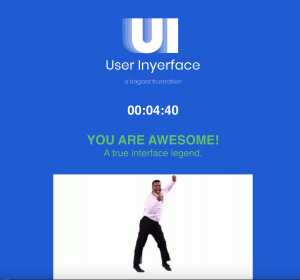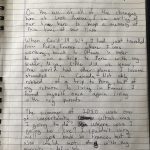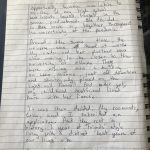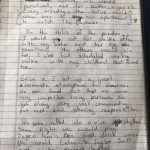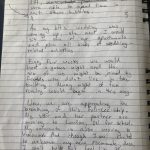Both Zoe’s and my voice-to-text analysis came up with a lot of similar points of reflection. For instance, how the software produced predictable mistakes and how writing by hand lends to more carefully crafted pieces.
I found it very interesting to see Zoe produce this assignment in both French and English. In my own use of voice-to-text software, I find the language aspect to be one of the most notable discrepancies in technology today. English language speech recognition is leagues ahead of any other language in terms of the quality of the software. I work with French voice-to-text software as well in my professional life, and I have noticed a huge difference especially when it comes to African French accents.
I also found it interesting that, because she did the assignment twice, once in English and once in French, she was able to comment also on how oral storytelling changes from one retelling to another. She her second telling in french had some different elements and omissions than her original telling.
I was extremely impressed with all of the work Jessica put into creating this game. I myself had skipped this task because I had just taken ETEC 544 (digital games and learning) and I knew just how much time can be put into struggling with the coding of a game. And I was even more impressed when I played the game! Jessica took the time to carefully organize the game into an effective, fun, choice-based, practice scenario. There was even background noise built into the design of the game! I found myself failing to save the patients because of my lack of knowledge and some poor choices.
The game mechanics of twine are actually quite rudimentary but effective here. In the context of training emergency response personnel, this is a low cost, high-return option. I could see the next most effective option would be VR or using actors to recreate a hospital environment. This twine is a useful way to make training fun and interactive. Learners are able to experience their own real-time feedback.
Sophy and I had similar reflections initially in our approaches to this assignment. we both had a difficult time expressing abstract concepts in our emoji stories. She had an additional issue of trying to maintain the integrity of a translation too. I would be curious to know which piece of media she was using in this assignment!
I did find that Sophy’s research went above and beyond what we were asked to do here. Specifically, Sophy’s reference to the example of a language created int he 1940s in a Shanghai ghetto really spoke to me. In his created ‘dialect’, Charles K. Bliss, created different clusters of symbols to portray more and more elaborate concepts. This connection made by Sophy really speaks to how language and communication are formed in the minds of humans. For instance, Bliss uses symbols of a + to show intensity. In English, we use prefixes and suffixes to add meaning to language. Sophy continues to explore this element of language formation by discussing how ‘joining emojis’ works to create a new emoji out of separate emojis. I thought this was a very well researched addition to her assignment.
Another important discussion Sophy brings to the table is the additional meaning making element of emojis. They represent the emotion that sometimes cannot be expressed by words. And similarly, this is contrasted with the fact that they cannot be used to express as much meaning as a textual description might. I think that is sometimes the beauty of language and how humans add meaning: every symbol created by humans to house meaning can be both meaningful and meaningless depending on the context of their use.
I loved Katie’s approach to this assignment. A soundscape is a great idea for this project because of the nature of the material items. Like she mentions, this adds an immersive experience for the viewer. The soundscape was meant to give the viewer a spatial sense of the items in Katie’s bag – something that may not be possible or effective with other modes.
She smartly identifies that some of the information is lost on the audience when communicating objects from a purely audible perspective. Though she adds visuals to compliment the soundscape, she notes that what is missing is actual contextual information about her items. She was then inspired to supplement this information within her own vocalized reflection, which she gave in a podcast style following the soundscape.
I found it interesting that she and I both attempted to bring a sense of spatial audio into our assignments. I wonder why this seemed to be a popular go-to strategy?
I was curious to go back and explore some of the conclusions of my colleagues for Task 9. Jane’s analysis was very clear and helped me see the task from a different point of view. Initially, I found it comforting that many of my colleagues seemed to be confused by the Palladio software as I was.
First, I found it interesting that she also found “representation” to be the most important criteria. Notably, she also accounted for non-man-made sounds, saying that she was seeking a good combination of natural and man-made sounds in her selection. I hadn’t previously thought of natural sounds as being very essential.
Jane made some very good points in assessing the data. Indeed, if the initial data had some additional features, we may better be able to extract information on the participants of the survey and their selection process. Jane proposes additional metadata be captured: 1) categorization tags could be used to better assess the choice-making process; and 2) if participants were able to enumerate their choices from most to least important, this would also help assess the criteria used.
I loved Sam’s in depth look at textbooks and the possible different futures. He smartly included a link to his final project in which he talks about the benefits of multimodal digital texts from the perspective of the future. This added a lot of well-researched insight to this task.
I like how Sam included small touches in his dystopian version as well to push his point home. For instance, in his dystopian future, cohorts remain unchanged throughout the students’ entire experience. This speaks to the isolation of a lack of new ideas in the classroom.
I like the idea of “The Textbook” to rule them all. This is such a good metaphor for prescriptive teaching practices. The Slogan “No one is left begin, and no one jumps ahead” is a perfect creepy interpretation of this future where equality is valued over equity.
It is super interesting to me that he specifically mentions that the textbook was developed kind of democratically with thousands of educators. I wonder if he was trying to imply that the textbook was erroneously created under good intentions. Is there any case in which a curriculum document could be created that could cater to global populations?




